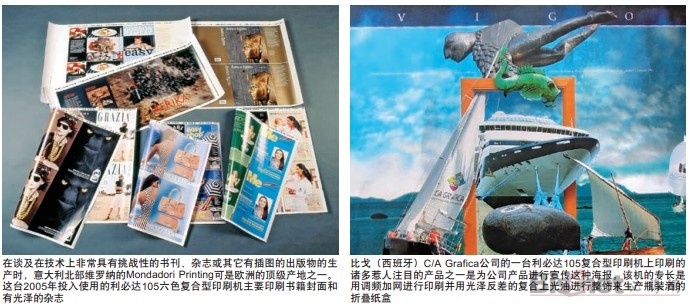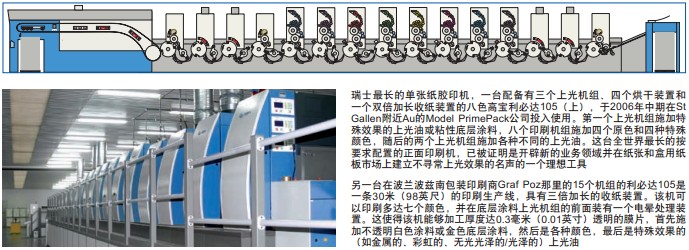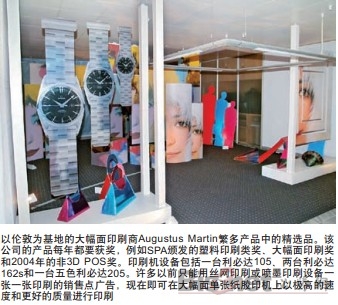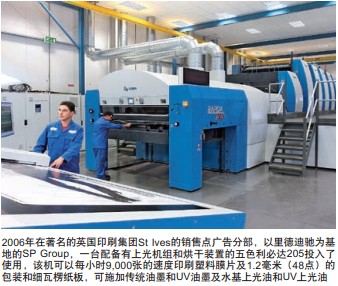KBA is a global technology leader in the online coating of sheet-fed offset printing. Numerous printing presses equipped with standard or custom glazing units installed by satisfied customers around the world provide evidence for this. More than that: KBA has accelerated the adoption of anilox roller technology in offset printing, developed composite varnishing to a perfect point, and provided other systems for varnishing cardboard and film in UV and waterless offset printing .
Varnish is growing
Printers all over the world are using online coating. This is because product and brand manufacturers must constantly introduce new design elements in order to differentiate their products and enhance their competitive image in the world market. This difference is achieved by exploiting the options available in printing technology for substrates, ink application, glazing and finishing. The ability to complete printing and glazing in a single pass provides an important competitive advantage.

KBA felt the pulse of this tendency through the technical requirements of customers on the new printing press. Over the years, among the small, medium and large format KBA presses that have been shipped, the machines with glazing equipment are between 40% and 60%. In the world, folding cartons and point-of-sale advertising have the highest proportion of such equipment. In the industrialized world, 80-85% of printing presses have the ability to coat online. This was followed by trademark printing (6 4-77%), commercial printing (13-50%) and book printing (up to 15%). Weighted by market capacity, folding carton? Point-of-sale advertising printing topped 72%, ahead of trademark printing (58%), commercial printing (21%) and book printing (12%).
Full-page glazing is the most popular form in the fields of trademarks, commerce and books, while partial glazing is preferred in the field of folding cartons and point-of-sale advertising. Partial lines and netting are more popular among book printers.
A survey of European printers by Weilburger Graphics shows that the proportion of UV varnishes and inks in total consumption is continuously increasing, which is most obvious in the UK and France. But most of the printers surveyed are still using overprint varnish and water-based varnish. In packaging printers, water-based and UV varnishes have been widely used, mainly because they have good quality, and achieving this quality depends largely on the anilox roller technology.

According to printing professionals, the key function of the varnish is to protect the newly printed image from damage by mechanical shock, thereby ensuring that the product can be completed according to regulations while eliminating the risk of processing-related downtime. However, although tighter delivery deadlines mean that production time plays an increasingly important role, the companies surveyed put more emphasis on product quality.

Online polishing business model
The large number of KBA printing machines with glazing capabilities reflects the strong attention paid by printers to the sophisticated and complex glazing on all types of products. This shows that the glazing oil that can be applied on the wet offset printing unit without the glazing unit can no longer meet the requirements for more challenging gloss glazing. Moreover, it takes a long time to dry the printing varnish, and it is not suitable as a protective layer for printed products, so that they can be finished without delay. However, it has worked hard to obtain a new application area, that is, to create a contrasting gloss effect with matte gloss and granulated varnish in composite production. Now more and more print suppliers adopt this method. It has been proved that the combination ink, together with the local printing varnish and the full version of high gloss UV glazing, is a real alternative to the dual glazing press for glazing-from aesthetics and economics The view is the same. It is also possible to apply traditional inks and water-based varnishes with a compound printer.
However, it is confirmed that only one (anilox roller) glazing unit can complete all types of work, not just the composite technology. For example, many printers have realized that full or partial application of water-based varnishes that can provide much more than protection and gloss is a very valuable tool that can expand their range of printed products with value-added products. . The gloss contrast can even be achieved with dripping or double-effect glazing (traditional ink plus local printing varnish plus full version water-based glazing oil), although the effect of doing so is not as good as the impression given by composite consumables profound.
The situation is similar in UV printing: many companies have found that applying a pure UV varnish instead of two varnishes will bring greater visual impact to the folding carton. In addition, the ability of UV printing and glazing has become a major source of revenue for more and more plastic and diaphragm printers. KBA-Metronic provides equipment for direct printing and glazing on plastic cards (OC200) or equipment for printing plastics in addition to paper and cardboard (Genius 52UV, more and more The model is equipped with a UV coating unit). The Rapida 74G equipped with water-free and ink-free key inking device can already have UV capability, and can be equipped with a double-glazing unit for short-lived printing and glazing of packaging and advertising products.

But the double glazing press is still the most versatile printing press. Their ability to apply primers means that they can print traditional inks and then apply high gloss UV varnish, or apply special effect varnish plus a layer of high gloss varnish. Some printing plants even put a printing machine with a glazing unit and a drying module in front of the first printing unit. This allows them to apply opaque white paint or special effect primers, then print on these paints and perform a second glaze to obtain additional brightness.
The most important point is that this complicated glazing process makes the packaging more difficult to counterfeit. At the same time, glazing can also be combined with additional anti-counterfeiting features such as Concealed Image Technology (CIT). KBA has developed this technology for use with composite glazing, so now this technology can not only place the hidden image in the screen structure of the dichroic film, but also place the image anywhere in the glazing image .


KBA has repeatedly provided its customers with new methods of online glazing, and these methods are not limited to glazing operations. For example, the glazing unit-like the last printing unit-can now be used for other mechanical finishing processes, such as die cutting. In doing so, the corresponding die-cut plate needs to be installed on the glazing plate cylinder, So that it can be combined with the impression cylinder in the glazing unit.
KBA will continue to focus on expanding the range of applications for printing presses through product additions and value-added advances, not just in online glazing.
MUshroom Shape Spout With Pouch
Shantou Oudaya Packaging Co. Ltd. , https://www.imloudaya.com